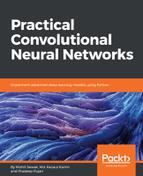We saw in the earlier section that Fast R-CNN brought down the time required for scoring (testing) images drastically, but the reduction ignored the time required for generating Region Proposals, which use a separate mechanism (though pulling from the convolution map from CNN) and continue proving a bottleneck. Also, we observed that though all three challenges were resolved using the common features from convolution-map in Fast R-CNN, they were using different mechanisms/models.
Faster R-CNN improves upon these drawbacks and proposes the concept of Region Proposal Networks (RPNs), bringing down the scoring (testing) time to 0.2 seconds per image, even including time for Region Proposals.

As shown in the earlier figure, a VGG16 (or another) CNN works directly on the image, producing a convolutional map (similar to what was done in Fast R-CNN). Things differ from here, where now there are two branches, one feeding into the RPN and the other into the detection Network. This is again an extension of the same CNN for prediction, leading to a Fully Convolutional Network (FCN). The RPN acts as an Attention Mechanism and also shares full-image convolutional features with the detection network. Also, now because all the parts in the network can use efficient GPU-based computation, it thus reduces the overall time required:

The RPN works in a sliding window mechanism, where a window slides (much like CNN filters) across the last convolution map from the shared convolutional layer. With each slide, the sliding window produces k (k=NScale × NSize) number of Anchor Boxes (similar to Candidate Boxes), where NScale is the number of (pyramid like) scales per size of the NSize sized (aspect ratio) box extracted from the center of the sliding window, much like the following figure.
The RPN leads into a flattened, FC layer. This, in turn, leads into two networks, one for predicting the four numbers for each of the k boxes (determining the coordinates, length and width of the box as in Fast R-CNN), and another into a binomial classification model that determines the objectness or probability of finding any of the given objects in that box. The output from the RPN leads into the detection network, which detects which particular class of object is in each of the k boxes given the position of the box and its objectness.

One problem in this architecture is the training of the two networks, namely the Region Proposal and detection network. We learned that CNN is trained using backpropagating across all layers while reducing the losses layers with every iteration. But because of the split into two different networks, we could at a time backpropagate across only one network. To resolve this issue, the training is done iteratively across each network, while keeping the weights of the other network constant. This helps in converging both the networks quickly.
An important feature of the RPN architecture is that it has translation invariance with respect to both the functions, one that is producing the anchors, and another that is producing the attributes (its coordinate and objectness) for the anchors. Because of translation invariance, a reverse operation, or producing the portion of the image given a vector map of an anchor map is feasible.
